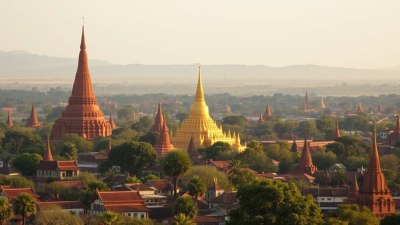In the Wake of Stillness in Bagan, Myanmar
Explore the tranquil beauty of Bagan, Myanmar, where ancient temples meet serene landscapes.

Image created with Flux Schnell
Bagan, a destination steeped in history and spirituality, invites travelers to explore its timeless beauty and profound tranquility. Nestled along the banks of the Ayeyarwady River in Myanmar, this ancient city is renowned for its breathtaking landscape dotted with thousands of temples, pagodas, and stupas, each bearing witness to the rich cultural heritage that flourished between the 9th and 13th centuries. The stillness found here offers an escape from the frenetic pace of modern life, allowing visitors to connect with the spiritual essence of this sacred ground.
As you wander through the expansive plains of Bagan, you'll encounter over 2,000 monuments that rise majestically against the backdrop of the sun-kissed horizon. Each temple tells a story, from the magnificent Ananda Temple, with its stunning golden stupa, to the intricate frescoes of the Thatbyinnyu Temple, the tallest in Bagan. Exploring on foot, by bike, or even on horseback creates a sense of intimacy with these ancient structures, enhancing the experience of stillness as you pause to observe the details carved into their facades.
Ancient Architecture and Spiritual Significance
The architectural style of Bagan is truly remarkable, reflecting the evolution of Theravada Buddhism in the region. Built predominantly in the 11th and 12th centuries, these temples showcase a variety of styles that fuse local artistry with influences from neighboring cultures. Each brick and statue represents not merely a structure but also a deep reverence for spirituality.
One can spend days exploring the temples of Bagan, with highlights including the majestic Dhammayangyi Temple, known for its massive size and unique construction, and the Sulamani Temple, celebrated for its exquisite stucco decorations. The intricate carvings found throughout Bagan’s temples depict scenes from the Jataka tales, a series of stories about the previous lives of the Buddha, inviting reflection on the nature of life and rebirth.
The Rhythm of Daily Life
Beyond the temples, the town of Nyaung-U acts as a hub for travelers seeking to immerse themselves in the local culture. Here, you’ll find bustling markets where artisans sell handmade goods, including lacquerware, a traditional craft that has been practiced in Bagan for centuries. While wandering through the market, take a moment to savor local flavors, including the famous Burmese tea and delicious snacks like Mohinga, a fish soup often considered the quintessential breakfast dish of Myanmar.
The stillness of Bagan is palpable during the early morning hours when the sun begins to rise, casting a warm glow on the pagodas and awakening the land with its gentle light. This is the perfect time for hot air balloon rides that offer breathtaking aerial views over the temples. As the balloons drift silently on the rising thermal currents, the panoramic vistas of Bagan reveal the interconnectedness of nature and heritage, a reminder of the fleeting beauty of life.
Connecting with Nature
The serene landscapes surrounding Bagan beckon travelers to explore not only its historical sites but also its natural beauty. The banks of the Ayeyarwady River provide a picturesque setting for leisurely boat rides that allow for introspection and appreciation of the environment. As you glide over the water, it’s not uncommon to spot local fishermen casting their nets or families engaging in daily routines, all while the soft lapping of the river creates a therapeutic melody.
Evenings in Bagan offer another opportunity for connection. The sunset views from various vantage points around the temples are legendary, with the sun dipping low and casting shades of orange, pink, and purple across the sky. Travelers often gather atop pagodas or hills to witness this daily spectacle, creating a communal experience that reflects the spirit of togetherness inherent in Myanmar’s culture.
Cultural Preservation and Challenges
While Bagan’s beauty is undeniable, it faces challenges that threaten its preservation. Natural disasters, such as earthquakes, and human interventions pose risks to these ancient structures and the delicate ecosystem in which they thrive. The Myanmar government and various organizations work diligently to protect and restore the sites, ensuring future generations can enjoy the serenity of Bagan. Efforts are being made to educate visitors about the importance of responsible tourism, emphasizing the need to respect the sacredness of the temples and the local customs.
Participating in local initiatives and supporting community-led projects can offer deeper insights into the culture while contributing to the sustainability of the region. Engaging with local guides who have intimate knowledge of Bagan’s history can deepen your appreciation and provide context that enriches your experience.
Reflections and Meaning
In the wake of stillness found in Bagan, one can find time for reflection and renewal. The tranquil setting allows visitors to escape the chaos of everyday lives and reconnect with what truly matters. Whether it’s through meditation, photography, or simply soaking in the surroundings, Bagan provides the perfect backdrop for personal exploration and mindfulness. As ancient temples stand resolute against the passage of time, they remind us of the importance of grounding ourselves amidst the storms of life.
Many visitors leave Bagan with a renewed sense of purpose and an appreciation for the beauty of simplicity, often carrying these lessons back to their own lives. The peaceful ambiance and stunning visuals serve as a reminder to cherish moments, to reflect inwardly, and to find stillness amidst our busy existences. The legacy of Bagan extends beyond its physical structures; it lies in the hearts of those who experience its profound tranquility, enabling them to carry its spirit into the world.
Plan Your Journey to Bagan
If you’re inspired to experience the stillness of Bagan for yourself, it’s essential to plan your visit thoughtfully. The best time to explore this ancient city is during the cooler months, from November to February, when the weather is mild and pleasant. Booking accommodations in advance is advisable, as this popular destination attracts travelers from all over the globe.
When arriving in Bagan, consider spending time in nearby areas, such as Mount Popa, a revered pilgrimage site, and the ancient city of Amarapura, to further enrich your experience. Explore the surrounding countryside by interacting with locals, learning about their traditions and way of life, and appreciating the natural beauty of the region.
In conclusion, the stillness found in Bagan offers a unique opportunity for connection, reflection, and discovery. It is a place where history, spirituality, and nature intertwine, creating an experience that resonates deeply with every traveler. Whether you find inspiration in the ancient temples, take solace in the serene landscapes, or connect with the vibrant culture of the local people, Bagan leaves an indelible mark on all who venture here.











